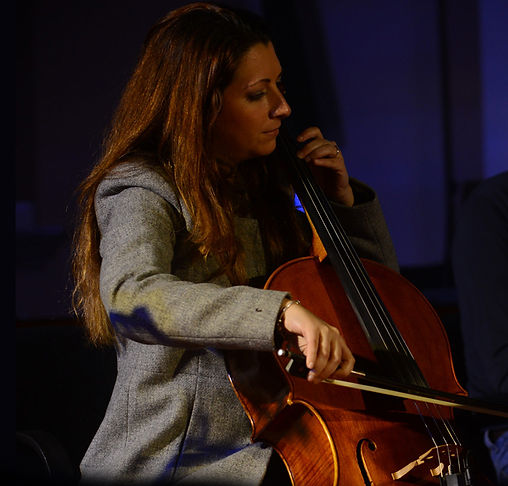MUSIC AND CONCEPT BY MARIA OLIVERO.
INSPIRED BY THE BOOK "MIELE E KEROSENE" (HONEY AND KEROSENE), BY LUCA DE ANTONIS.
LOVE ABOVE ALL!
In the heart of Europe. The extraordinary story of Joséphine Baker told in the musical work written and produced by Maria Olivero, defined by her son Jean-Claude Baker as "a labor of love".

STILL MY HEART BEATS, MY JOSÉPHINE BAKER
MUSIC AND CONCEPT BY MARIA OLIVERO
“Dear Maria, nice to hear the latest news about your labour of love…
with tenderness and respect, Jean-Claude Baker”.
NOVEL
inspired by the book "Miele e Kerosene"
by Luca De Antonis
in Italian, French, English
MUSIC
Maria Olivero
ORIGINAL SONGS
music by Maria Olivero, lyrics by Elena Maro
LIGHTS DESIGNED
darkned with spotlights
LENGHT
one hour and 15 minutes
MARIA OLIVERO
vocal, piano, acoustic guitar,
dulcimer, harmonica
ROSSANA GIROTTO
narrator
LUCIA COLOMBO
cello
GIULIA RIBOLI
theremin
VINCENZO ZITELLO
harp, tin whistle

" ... I FELT HER CLOSE AND I STRONGLY FELT THE SENSE OF SWEETNESS AND REBELLION, HER STRENGTH AND HER COURAGE. I WANTED TO COMPOSE A MUSICAL WORK WITH CLASSICAL AND ELECTRONIC INSTRUMENTS TOGETHER... A UNIQUE AND RICH MUSICAL BODY."
Maria Olivero, author, composer, singer-songwriter
Maria Olivero has been studying the figure of Joséphine Baker since 2013, she created the show and wrote the music for “Still My Heart Beats, My Joséphine Baker”; on stage since 2016.
She met her son, Jean-Claude Baker in Manhattan who called it "a labor of love".
The show was presented on several occasions, at the Casa Teatro Ragazzi e Giovani in Turin, in Milan at the Frigoriferi Milanesi, at the Fabbrica Del Vapore in Milan, at the Murate in Florence, at the Faraggiana theater and at the Teatro Coccia in Novara where Joséphine performed in 1969 and 1932...
Important and current content is combined with a high level of quality and musical innovation.

Joséphine Baker arrived in Paris in 1925 aboard the transatlantic Berengaria, at just 19 years old, together with Caroline Dudley Delteil, the entrepreneur who discovered her and wanted her in "La Revue Nègre".
It debuted on 2 October of that year at the Théâtre des Champs-Elysées;
a sensational success.
Around her the artistic and cultural dynamism of the Ville Lumière.
The modernity that breaks into history.
"SO SENSITIVE, POETIC AND NOSTALGIC YOUR SWEET MELODIES TO CELEBRATE JOSÉPHINE, HER LIFE OF LOVE AND COURAGE! AS CAROLINE SAID IN 1925 FOR THE REVUE: ‘AND WE DID IT!’ AND YOU, MARIA, DID IT FOR THEM TOO!"
Alice Ciardi Ducros, fondatrice présidente de l'association Carré Joseph-Delteil.
In Maria Olivero's musical concept, classical and electronic instruments break the mould.
The composition lives ideally in the "spark in search of a powder keg";
in the Paris "Poésie, Liberté, Amour" by André Breton.


Giulia Riboli, theremin player, synth
The theremin, the first electronic instrument in history based on electromagnetic fields (1919), fascinates and sublimates the Paris of Breton and Soupault, the authors of the first surrealist work "The Magnetic Fields" (1919). The Joséphine's essence lives in sound, in connections, immaterial, revolutionary, tenacious and free like ideas.

Lucia Colombo on cello

Giulia Riboli, theremin, synth

Maria Olivero recording at Griffa Pianoforti in Milan

Maria Olivero in studio with Lucia Colombo
In the dark spotlights illuminate the scene: an actress/narrator, a piano, the musicians, while in the background flow suggestive images projected in black and white.



Rossana Girotto, narrator
Several artistic collaborations on stage, such as the great harpist Vincenzo Zitello

Vincenzo Zitello

Maria Olivero with Vincenzo Zitello recording at Pianoforti Griffa in Milan
Actress Paola Gassman reads an excerpt from the speech that Joséphine gave at the March in Washington, projected on video.


Paola Gassman and Maria Olivero, Turin, november 2017
Inspired by "Miele e Kerosene" (Honey and Kerosene) the book by Luca De Antonis


MUSIC – THE SHOW
Ups and downs, adversity and opportunity, black and white, America and France, men and women, wild and glamorous dance. Joséphine's life runs on a track of extraordinary duality.
In Maria Olivero's musical concept, classical and electronic instruments break the mould. The composition lives ideally in the "spark in search of a powder keg", in the Paris "Poésie, Liberté, Amour" by André Breton. The piano is load-bearing, accompanied by the solo cello and a string section.
A warm sound body fascinates and excites. The theremin, the first electronic instrument in history based on electromagnetic fields (1919), fascinates and sublimates the Paris of Breton and Soupault, the authors of the first surrealist work "The Magnetic Fields" (1919). The Joséphine's essence lives in sound, in connections, immaterial, revolutionary, tenacious and free like ideas.
The show celebrates the spirit of Joséphine, her simplicity and elegance, her research and heart, a direct style, deep in content; its essence returns in the intensity of the music and in the magic of the melodies composed by Maria Olivero.
In the dark spotlights illuminate the scene: an actress/narrator, a piano, the musicians, while in the background flow suggestive images projected in black and white.
The show has been presented on several occasions, at the Casa Teatro Ragazzi e Giovani in Turin, in Milan at the Fabbrica Del Vapore, at the Frigoriferi Milanesi, at the Murate in Florence, at the Faraggiana theatre and at the Teatro Coccia in Novara where Joséphine performed in 1969 and 1932. Actress Paola Gassman reads an excerpt from the speech that Joséphine gave at the March in Washington, projected on video. Several artistic collaborations on stage, such as the great harpist Vincenzo Zitello.